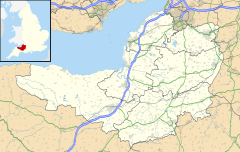Chilton Polden
| Chilton Polden | |
|---|---|
 Chilton Priory |
|
| Chilton Polden shown within Somerset | |
| Population | 698 (2011) |
| OS grid reference | ST374396 |
| District | |
| Shire county | |
| Region | |
| Country | England |
| Sovereign state | United Kingdom |
| Post town | BRIDGWATER |
| Postcode district | TA7 |
| Dialling code | 01278 |
| Police | Avon and Somerset |
| Fire | Devon and Somerset |
| Ambulance | South Western |
| EU Parliament | South West England |
| UK Parliament | |
Chilton Polden is a rural village and civil parish, situated close to Edington on the Somerset Levels to the north of the Polden Hills in the Sedgemoor district of Somerset, England.
The name of the village is thought to derive from its position on limestone and from the hill on which part of the parish lies. The form Chelton upon Poledowne is found in 1664. The Polden estate was given to Glastonbury Abbey by Æthelheard of Wessex in 729.
Chilton Priory (also known as Stradling's Folly) was originally built as a folly, and subsequently enlarged to become a country house. The tower and wing at the rear were built in 1838, for William Stradling. Stradling also incorporated various pieces of buildings and archaeological relics from around the county, especially materials from a Roman Villa at Chedzoy. The upper windows, battlements and grotesque heads came from a demolished castle at Enmore and the pinnacles from an old church tower at Langport. The staircase turret came from a church in Shepton Mallet and three of the windows in the nave from a chapel at Slapeland. The Priory has more recently been home to Katherine Maltwood who was an artist and became known as the discoverer of the Glastonbury Zodiac (otherwise known as the Temple of the Stars), an enormous geomantic creation surrounding the Tor at Glastonbury. The Temple was another folly tower, built by Stradling in the early 19th incorporating re-used 15th features.
The village gives its name to the ambling piano piece The Way to Polden (Op. 76) by British composer York Bowen.
...
Wikipedia

